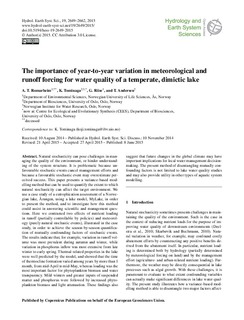| dc.contributor.author | Romarheim, Aleksandra Tmic | |
| dc.contributor.author | Tominaga, Koji | |
| dc.contributor.author | Riise, Gunnhild | |
| dc.contributor.author | Andersen, Tom | |
| dc.date.accessioned | 2018-07-31T11:29:04Z | |
| dc.date.available | 2018-07-31T11:29:04Z | |
| dc.date.created | 2015-06-09T05:37:39Z | |
| dc.date.issued | 2015 | |
| dc.identifier.citation | Hydrology and Earth System Sciences. 2015, 19 (6), 2649-2662. | nb_NO |
| dc.identifier.issn | 1027-5606 | |
| dc.identifier.uri | http://hdl.handle.net/11250/2506976 | |
| dc.description.abstract | Natural stochasticity can pose challenges in managing the quality of the environment, or hinder understanding of the system structure. It is problematic because unfavourable stochastic events cancel management efforts and because a favourable stochastic event may overestimate perceived success. This paper presents a variance-based modelling method that can be used to quantify the extent to which natural stochasticity can affect the target environment. We use a case study of a eutrophication assessment of a Norwegian lake, Årungen, using a lake model, MyLake, in order to present the method, and to investigate how this method could assist in answering scientific and management questions. Here we contrasted two effects of nutrient loading in runoff (partially controllable by policies) and meteorology (purely natural stochastic events), illustrated in the case study, in order to achieve the season-by-season quantification of mutually confounding factors of stochastic events. The results indicate that, for example, variation in runoff volume was most prevalent during autumn and winter, while variation in phosphorus inflow was most extensive from late winter to early spring. Thermal-related properties in the lake were well predicted by the model, and showed that the time of thermocline formation varied among years by more than 1 month, from mid-April to mid-May, whereas loading was the most important factor for phytoplankton biomass and water transparency. Mild winters and greater inputs of suspended matter and phosphorus were followed by increased phytoplankton biomass and light attenuation. These findings also suggest that future changes in the global climate may have important implications for local water management decisionmaking. The present method of disentangling mutually confounding factors is not limited to lake water quality studies and may also provide utility in other types of aquatic system modelling. | nb_NO |
| dc.language.iso | eng | nb_NO |
| dc.publisher | European Geosciences Union | nb_NO |
| dc.rights | Attribution 3.0 Unported (CC BY 3.0) | * |
| dc.rights.uri | https://creativecommons.org/licenses/by/3.0/ | * |
| dc.title | The importance of year-to-year variation in meteorological and runoff forcing for water quality of a temperate, dimictic lake | nb_NO |
| dc.type | Journal article | nb_NO |
| dc.type | Peer reviewed | nb_NO |
| dc.description.version | publishedVersion | nb_NO |
| dc.rights.holder | © Author(s) 2015 | nb_NO |
| dc.source.pagenumber | 2649-2662 | nb_NO |
| dc.source.volume | 19 | nb_NO |
| dc.source.journal | Hydrology and Earth System Sciences | nb_NO |
| dc.source.issue | 6 | nb_NO |
| dc.identifier.doi | 10.5194/hess-19-2649-2015 | |
| dc.identifier.cristin | 1247006 | |
| dc.relation.project | Norges forskningsråd:190028 | nb_NO |
| cristin.unitcode | 7464,0,0,0 | |
| cristin.unitname | Norsk institutt for vannforskning | |
| cristin.ispublished | true | |
| cristin.fulltext | original | |
| cristin.qualitycode | 2 | |

